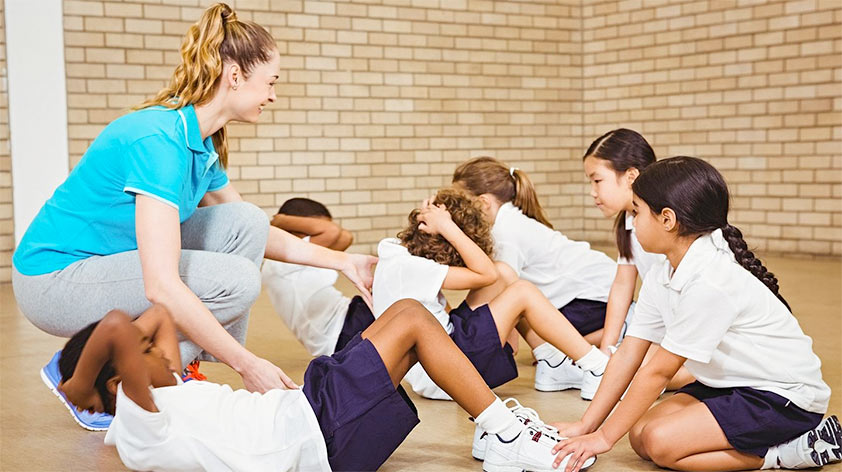
Creating inclusive physical education programs is essential in today’s diverse educational environments. It’s imperative that every student, with their unique abilities and varied backgrounds, has access to a PE class that not only meets their individual needs but also offers meaningful challenges and active engagement.
This comprehensive guide is designed to equip educators with actionable strategies and insights to ensure their PE programs are not just accommodating but also vibrant and effective spaces for all students to thrive.
By emphasizing inclusivity, we aim to transform physical education into a dynamic, supportive, and engaging part of every student’s educational journey.
1. Understand Inclusion in PE
Inclusion in physical education goes beyond simply integrating students with physical disabilities into general education classes. It’s about creating a learning space where every student feels valued and has equal opportunities to participate regardless of their physical, cognitive, or emotional differences.
Understanding inclusion means recognizing the varied needs of students and striving to provide an equitable educational experience that encourages all students to reach their full potential.
To truly embrace inclusion, educators must adopt a mindset that sees every student’s unique abilities as an opportunity for enriching the PE curriculum. This requires being mindful of different learning styles, physical abilities, and interests.
By doing so, you make PE a subject that promotes physical health and builds confidence, social skills, and a sense of community among students.
2. Pursue Further Education
Enhancing your knowledge and skills through further education is pivotal in creating inclusive physical education programs. Enrolling in a masters in physical education online provides an excellent opportunity to delve deeper into adaptive physical education techniques and inclusive teaching practices.
These programs are designed for working professionals, offering the flexibility to balance career advancements with educational pursuits. Advanced education can arm you with the latest strategies and research-backed methods to meet the diverse needs of your students.
You’ll learn about designing adaptable PE curriculums, incorporating technology and assistive devices, and understanding the psychological aspects of teaching students with varying needs. This advanced knowledge will enable you to create a PE program that is not only inclusive but also innovative and impactful.
3. Assess and Adapt Activities
Key to an inclusive PE program is the ability to assess individual needs and adapt activities accordingly. Differentiation is crucial; it involves tailoring instruction to meet individual learning needs. This could mean modifying games to ensure they are accessible to everyone or offering alternative activities that provide similar physical benefits.
Assessment should be ongoing, allowing you to adjust your teaching methods and activities based on your students’ changing needs and abilities. This approach ensures that all students can participate fully and benefit from PE, regardless of their physical capabilities.
4. Foster a Positive Environment
The atmosphere of your PE class plays a significant role in making it inclusive. A positive environment is one where diversity is celebrated and every student’s effort is recognized and appreciated. Encouraging students to support and cheer for one another can significantly enhance their self-esteem and motivation.
To foster such an environment, emphasize the value of effort, improvement, and teamwork over winning or athletic prowess. Introduce activities that require cooperation and promote understanding among students with different abilities.
This helps build a supportive community and teaches important life skills such as empathy, respect, and communication.
5. Implement Universal Design for Learning (UDL)
Universal Design for Learning (UDL) is an educational framework based on the principle of creating curriculum materials and activities that cater to the broadest possible range of learners.
Implementing UDL in physical education means offering multiple ways for students to engage with the material, represent what they know, and express what they have learned. This approach ensures that learning opportunities are accessible to all students, regardless of their abilities or disabilities.
For instance, in a PE setting, this could involve providing visual, auditory, and kinesthetic cues for a game or activity, allowing students to understand and participate in the way that best suits their learning style. It also means offering various options for demonstrating skill mastery, from traditional physical demonstrations to creative presentations or written reflections.
6. Use Assistive Technologies and Equipment
Incorporating assistive technologies and adaptive equipment can make a significant difference in making physical education programs accessible to all students. Simple modifications, such as using balls with different textures or sizes, can help students with visual impairments or fine motor challenges participate more fully in activities.
Similarly, specialized equipment like wheelchairs designed for sports or the use of apps that provide auditory cues for students who are deaf or hard of hearing can open up new opportunities for inclusion. The key is to assess the specific needs of your students and seek out resources and technologies that can help bridge any gaps in participation.
This proactive approach not only enhances accessibility but also demonstrates to students that their participation in PE is valued and that there are no barriers to their full involvement.
7. Offer Choice and Voice
Giving students a choice in the activities they participate in can significantly boost their engagement and motivation. When students feel they have a say in their learning, they are likelier to take an active interest and put forth their best effort.
In the context of an inclusive PE program, offering choices allows students with diverse abilities and interests to select activities that they feel comfortable with and enjoy. This might involve letting students choose between different sports or physical activities for a particular lesson or offering different roles within a game, such as playing, refereeing, or coaching.
By providing options, you empower students to take control of their physical education experience, encouraging them to be more involved and invested in their own learning.
Conclusion
Building inclusive physical education programs is a process that requires dedication, creativity, and a commitment to understanding and meeting the diverse needs of all students.
By implementing Universal Design for Learning, utilizing assistive technologies and equipment, offering choices to students, and engaging in professional development and collaboration, educators can create PE classes that are truly inclusive.
Such an environment promotes physical health and wellness and fosters a sense of belonging and community among students. It teaches valuable life lessons about diversity, acceptance, and perseverance.
Through thoughtful planning and a commitment to inclusion, PE can be a powerful vehicle for positive change in the educational experience of every student.









